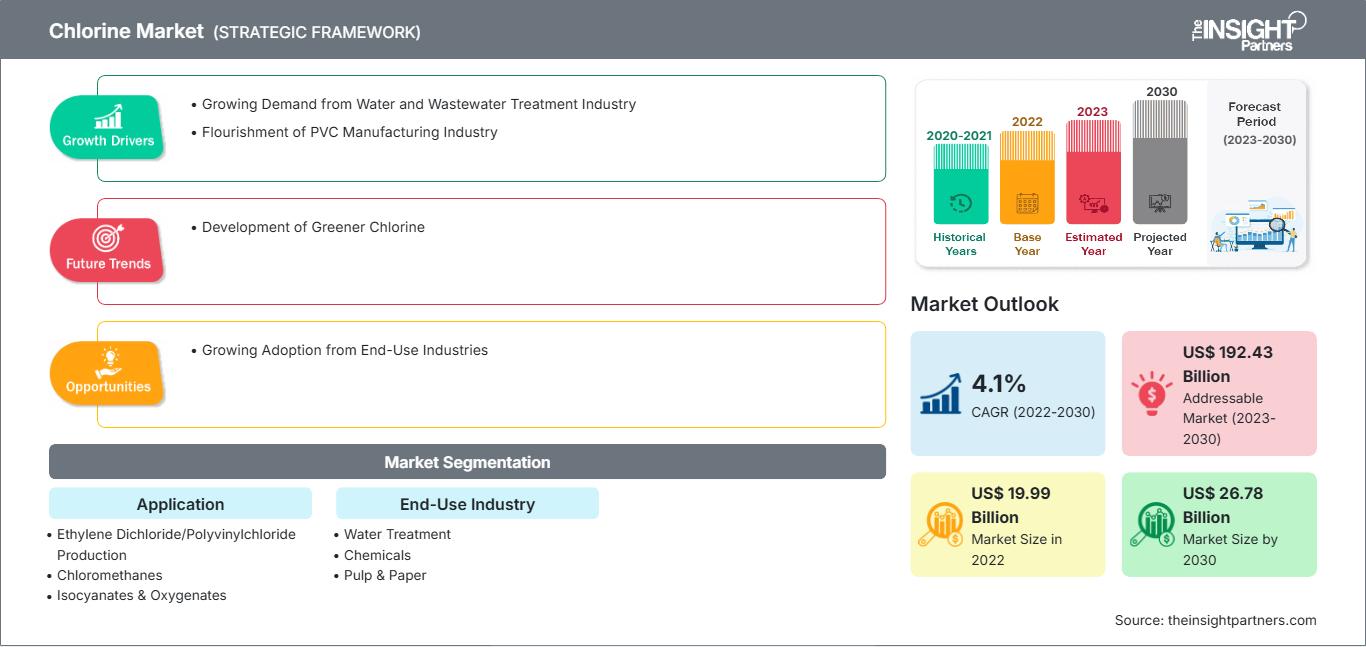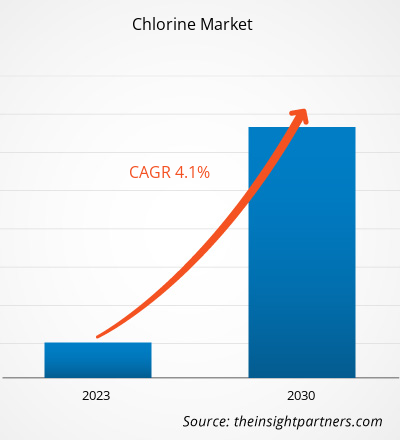[Forschungsbericht] Der Chlormarkt hatte im Jahr 2022 ein Volumen von 19.988,92 Millionen US-Dollar und soll bis 2030 26.777,66 Millionen US-Dollar erreichen; von 2022 bis 2030 wird ein durchschnittliches jährliches Wachstum von 4,1 % erwartet.
Markteinblicke und Analystenmeinung:
Chlor ist eine vielseitige Chemikalie mit einer Vielzahl von Endverbraucherbranchen, wie z. B. der Wasseraufbereitung, der Chemie, der Zellstoff- und Papierindustrie sowie der Kunststoffindustrie. Es wird durch Elektrolyse von Natriumchloridlösung mithilfe einer Diaphragmazelle und einer Membranzelle hergestellt. Es ist ein wichtiger Rohstoff für verschiedene Produkte und Prozesse in unterschiedlichen Branchen. Chlor wird häufig als Desinfektionsmittel in kommunalen Wasseraufbereitungsanlagen eingesetzt, um schädliche Bakterien, Viren und andere Krankheitserreger zu zerstören und so die Sicherheit und Qualität des Trinkwassers zu gewährleisten. Darüber hinaus ist Chlor ein wichtiger Bestandteil der Polyvinylchlorid-(PVC-)Produktion. PVC wird in Anwendungen wie Rohren, Fensterrahmen, Fußböden, Verpackungsfolien und Automobilkomponenten verwendet. Die Pharmaindustrie nutzt Chlor zur Synthese pharmazeutischer Wirkstoffe (APIs) und anderer pharmazeutischer Verbindungen. Chlor wird zur Herstellung von Pestiziden, Herbiziden und anderen Agrochemikalien zum Schutz von Nutzpflanzen und zur Verbesserung der landwirtschaftlichen Produktivität verwendet. Es wird auch in verschiedenen chemischen Reaktionen eingesetzt, um chlorierte Verbindungen herzustellen, die in vielen industriellen Anwendungen wie Lösungsmitteln, Bleichmitteln und Reinigungsprodukten zum Einsatz kommen. Chlor wird in der Elektronikfertigung zum Verkleben von Komponenten und zum Schutz empfindlicher Teile eingesetzt. Diese Faktoren werden voraussichtlich das Wachstum des Chlormarktes vorantreiben.
Wachstumstreiber und Herausforderungen:
Robuste Wasserdesinfektionsmethoden sind mit der Zunahme antibiotikaresistenter Bakterien und der Entstehung wasserübertragener Krankheiten von entscheidender Bedeutung geworden. Neben seiner primären Funktion bei der Entfernung von Krankheitserregern wird Chlor in der Wasseraufbereitung eingesetzt, um das Wachstum von Algen und Algentoxinen zu kontrollieren, Eisen und Mangan zu entfernen und weitere Probleme mit der Wasserqualität zu lösen. Die steigende Nachfrage der Wasser- und Abwasserindustrie nach Chlor aufgrund des steigenden Wasserverbrauchs der wachsenden Weltbevölkerung und der zunehmenden Notwendigkeit, sicheres und sauberes Trinkwasser zu gewährleisten, treibt das Wachstum des Chlormarktes voran. Darüber hinaus werden PVC-Folien und -Platten häufig in Verpackungsanwendungen eingesetzt, insbesondere für Lebensmittel und Pharmaprodukte. Mit der steigenden Nachfrage nach Verpackungsgütern und dem zunehmenden Fokus auf Hygiene und Produktsicherheit ist die Nachfrage nach PVC-basierten Verpackungsmaterialien sprunghaft angestiegen, was den Chlorbedarf der PVC-Industrie weiter steigert. Im Elektrosektor werden PVC-Kabel und -Leitungen aufgrund ihrer hervorragenden elektrischen Eigenschaften und ihrer feuerhemmenden Eigenschaften häufig zur elektrischen Isolierung eingesetzt. Da der weltweite Bedarf an Elektrizität und elektrischer Infrastruktur weiter steigt, steigt auch der Bedarf an PVC-basierten Elektromaterialien und damit die Chlornachfrage. Da PVC nach wie vor ein bevorzugter Werkstoff im Bauwesen, in der Automobilindustrie, bei Verpackungen und in der Elektroindustrie ist, bleibt der Bedarf an Chlor im Polymerisationsprozess hoch. Die steigende Nachfrage aus der Wasseraufbereitung, der PVC-Herstellung und anderen Endverbrauchsindustrien treibt das Wachstum des Chlormarktes voran.
Die hohe Produktion, Handhabung und Entsorgung von Chlor in verschiedenen Industrien und Anwendungen birgt potenzielle Risiken für die menschliche Gesundheit und die Umwelt. Regierungen weltweit haben diese Risiken erkannt und strenge Vorschriften erlassen, um einen sicheren und verantwortungsvollen Umgang mit Chlor zu gewährleisten. Daher wirken sich Bedenken hinsichtlich des Chlorgebrauchs und zunehmende Vorschriften zur Kontrolle des Chlorgebrauchs negativ auf das Wachstum des Chlormarktes aus.
Passen Sie diesen Bericht Ihren Anforderungen an
Sie erhalten kostenlos Anpassungen an jedem Bericht, einschließlich Teilen dieses Berichts oder einer Analyse auf Länderebene, eines Excel-Datenpakets sowie tolle Angebote und Rabatte für Start-ups und Universitäten.
Chlormarkt: Strategische Einblicke

-
Holen Sie sich die wichtigsten Markttrends aus diesem Bericht.Dieses KOSTENLOSE Beispiel umfasst Datenanalysen, die von Markttrends bis hin zu Schätzungen und Prognosen reichen.
Berichtssegmentierung und -umfang:
Der globale Chlormarkt ist nach Anwendung, Endverbrauchsbranche und Geografie segmentiert. Basierend auf der Anwendung ist der Chlormarkt in die Produktion von Ethylendichlorid/Polyvinylchlorid, Chlormethanen, Isocyanaten und Oxygenaten, Lösungsmitteln und anderen segmentiert. In Bezug auf die Endverbrauchsbranche ist der Chlormarkt in Wasseraufbereitung, Chemikalien, Zellstoff und Papier, Kunststoffe, Pharmazeutika und anderen segmentiert. Geografisch ist der Chlormarkt in Nordamerika (USA, Kanada und Mexiko), Europa (Deutschland, Frankreich, Italien, Großbritannien, Russland und übriges Europa), Asien-Pazifik (Australien, China, Japan, Indien, Südkorea und übriger Asien-Pazifik-Raum), Naher Osten und Afrika (Südafrika, Saudi-Arabien, Vereinigte Arabische Emirate und übriger Naher Osten und Afrika) sowie Süd- und Südamerika unterteilt. Mittelamerika (Brasilien, Argentinien und der Rest von Süd- und Mittelamerika).
Segmentanalyse:
Basierend auf der Anwendung ist der Chlormarkt in die Produktion von Ethylendichlorid/Polyvinylchlorid, Chlormethanen, Isocyanaten und Oxygenaten, Lösungsmitteln und anderen segmentiert. Das Segment Isocyanate und Oxygenate wird voraussichtlich von 2022 bis 2030 ein signifikantes Wachstum verzeichnen. Isocyanate werden in großem Umfang bei der Herstellung von Polyurethan verwendet, einem vielseitigen Material, das in Schäumen, Klebstoffen, Dichtungsmitteln, Beschichtungen und Elastomeren verwendet wird. Diese Polyurethanmaterialien finden Anwendung in Produkten wie Möbeln, Matratzen, Autoteilen, Isolierungen und Schuhen. Obwohl Chlor im Polyurethanmolekül nicht vorkommt, wird es zur Herstellung der Zwischenprodukte, der Isocyanate, verwendet.
Oxygenate sind eine breite Klasse organischer Verbindungen, die Sauerstoffatome enthalten, typischerweise in Form von Hydroxylgruppen. Einige gängige Arten von Oxygenaten sind Alkohole (z. B. Ethanol und Methanol), Ether (z. B. Methyl-tert-butylether) und Ketone (z. B. Aceton). Oxygenate finden vielfältige Anwendung als Lösungsmittel, Kraftstoffzusätze und chemische Zwischenprodukte in verschiedenen Branchen. Ethanol wird beispielsweise als Biokraftstoffzusatz verwendet, um Emissionen zu reduzieren und die Kraftstoffleistung zu verbessern. Chlor spielt eine entscheidende Rolle in chemischen Prozessen mit chlorierten Zwischenprodukten. Bei der Chlorierung von Methan kann Methylchlorid entstehen, das in einer Reihe von chemischen Reaktionen Methanol produziert. All diese Faktoren treiben das Wachstum des Segments Isocyanate und Oxygenate im Chlormarkt voran.
Regionale Analyse:
Geografisch ist der Chlormarkt in fünf Schlüsselregionen unterteilt: Nordamerika, Europa, Asien-Pazifik, Süd- und Mittelamerika sowie Naher Osten und Afrika. Der globale Chlormarkt wurde vom asiatisch-pazifischen Raum dominiert, auf den im Jahr 2022 rund 9.500 Millionen US-Dollar entfielen. Die Region hat sich zu einem globalen Produktionszentrum entwickelt, mit Branchen aus den Bereichen Chemie, Textilien, Kunststoffe und Elektronik. Chlor ist eine wichtige Chemikalie in verschiedenen industriellen Prozessen, beispielsweise bei der Herstellung von Chemikalien, Lösungsmitteln und Zwischenprodukten für Arzneimittel. Die steigenden Produktionsaktivitäten in der gesamten Region zur Deckung des nationalen und internationalen Bedarfs dürften die Nachfrage nach Chlor, einem wichtigen Rohstoff, ankurbeln. Daher wird erwartet, dass die Nachfrage nach Chlor und seinen Derivaten mit dem Fortschritt und der Industrialisierung der Region stark bleibt, was das Wachstum des Chlormarktes im asiatisch-pazifischen Raum von 2023 bis 2030 ankurbeln dürfte. Für Europa wird von 2023 bis 2030 eine durchschnittliche jährliche Wachstumsrate von über 4 % erwartet. Die Region ist für verschiedene Anwendungen auf Chlor und seine Derivate angewiesen, was zu einer stetigen und anhaltenden Nachfrage nach dieser vielseitigen Chemikalie führt. Die Nachfrage nach Chlor steigt in der Abwasserbehandlung in Europa aus mehreren Gründen, die die Bedeutung von Chlor als wichtiges Wasserdesinfektionsmittel unterstreichen. Im Bestreben der europäischen Länder, die Wasserqualität zu verbessern, die öffentliche Gesundheit zu schützen und strenge Umweltvorschriften einzuhalten, hat sich Chlor als zuverlässige und effektive Lösung für die Abwasserbehandlung etabliert. All diese Faktoren treiben das Wachstum des Chlormarktes in Europa voran. Auch in Nordamerika wird ein deutliches Wachstum erwartet, das im Jahr 2030 über 5.500 Millionen US-Dollar erreichen wird.
Branchenentwicklungen und zukünftige Chancen:
Verschiedene Initiativen der wichtigsten Akteure auf dem Chlormarkt sind nachstehend aufgeführt:
- Im Dezember 2022 schloss INEOS Enterprises die Übernahme von ASHTA Chemicals von Bigshire Mexico S. de RL de CV ab. Der Deal umfasst eine Chloranlage mit einer Kapazität von 100 ktpa Kaliumhydroxid (KOH)/65 kte.
- Im April 2022 gab OxyVinyls, die Chemieabteilung von Occidental Petroleum, bekannt, dass sie ein 1,1 Milliarden US-Dollar teures Erweiterungs- und Modernisierungsprojekt in ihrer Chlor-Alkali-Anlage in La Porte, Texas, plant. Dies geht aus Dokumenten hervor, die beim Texas Comptroller's Office eingereicht wurden. Büro.
Auswirkungen von COVID-19:
Die COVID-19-Pandemie hatte negative Auswirkungen auf fast alle Branchen in verschiedenen Ländern. Lockdowns, Reisebeschränkungen und Betriebsschließungen in Nordamerika, Europa, im asiatisch-pazifischen Raum (APAC), Süd- und Mittelamerika sowie im Nahen Osten und Afrika (MEA) bremsten das Wachstum mehrerer Branchen, darunter der Chemie- und Werkstoffindustrie. Die Schließung von Produktionsstätten von Chlorunternehmen störte die globalen Lieferketten, Fertigungsaktivitäten und Lieferpläne. Verschiedene Unternehmen meldeten Verzögerungen bei Produktlieferungen und einen Einbruch ihrer Produktverkäufe im Jahr 2020. Die meisten industriellen Produktionsanlagen wurden während der Pandemie geschlossen, was den Chlorverbrauch verringerte. Darüber hinaus hat die COVID-19-Pandemie Schwankungen der Chlorpreise verursacht. Verschiedene Branchen nahmen jedoch ihren Betrieb wieder auf, nachdem die Lieferengpässe gelöst waren, was zu einer Wiederbelebung des Chlormarktes führte. Darüber hinaus fördert die steigende Nachfrage nach Chlor aus dem Industrie- und Wohnbereich das Wachstum des Chlormarktes erheblich.
Chlor
Regionale Einblicke in den ChlormarktDie Analysten von The Insight Partners haben die regionalen Trends und Faktoren, die den Chlormarkt im Prognosezeitraum beeinflussen, ausführlich erläutert. In diesem Abschnitt werden auch die Marktsegmente und die geografische Lage in Nordamerika, Europa, dem asiatisch-pazifischen Raum, dem Nahen Osten und Afrika sowie Süd- und Mittelamerika erörtert.
Umfang des Chlormarktberichts
| Berichtsattribut | Einzelheiten |
|---|---|
| Marktgröße in 2022 | US$ 19.99 Billion |
| Marktgröße nach 2030 | US$ 26.78 Billion |
| Globale CAGR (2022 - 2030) | 4.1% |
| Historische Daten | 2020-2021 |
| Prognosezeitraum | 2023-2030 |
| Abgedeckte Segmente |
By Anwendung
|
| Abgedeckte Regionen und Länder |
Nordamerika
|
| Marktführer und wichtige Unternehmensprofile |
|
Dichte der Akteure auf dem Chlormarkt: Verständnis ihrer Auswirkungen auf die Geschäftsdynamik
Der Chlormarkt wächst rasant, angetrieben durch die steigende Endverbrauchernachfrage aufgrund von Faktoren wie sich entwickelnden Verbraucherpräferenzen, technologischem Fortschritt und einem stärkeren Bewusstsein für die Produktvorteile. Mit steigender Nachfrage erweitern Unternehmen ihr Angebot, entwickeln Innovationen, um den Verbraucherbedürfnissen gerecht zu werden, und nutzen neue Trends, was das Marktwachstum weiter ankurbelt.

- Holen Sie sich die Chlormarkt Übersicht der wichtigsten Akteure
Wettbewerbslandschaft und Schlüsselunternehmen:
Aditya Birla Chemicals India Ltd, BASF SE, Ercros SA, Hanwha Solutions Corp, INEOS Group Holdings SA, Occidental Petroleum Corp, Olin Corp, Tata Chemicals Ltd, Vynova Belgium NV und Sumitomo Chemical Co Ltd gehören zu den Akteuren auf dem globalen Chlormarkt. Die Akteure des globalen Chlormarktes konzentrieren sich auf die Bereitstellung qualitativ hochwertiger Produkte, um die Kundennachfrage zu erfüllen.
- Historische Analyse (2 Jahre), Basisjahr, Prognose (7 Jahre) mit CAGR
- PEST- und SWOT-Analyse
- Marktgröße Wert/Volumen – Global, Regional, Land
- Branchen- und Wettbewerbslandschaft
- Excel-Datensatz
Aktuelle Berichte
Erfahrungsberichte
Grund zum Kauf
- Fundierte Entscheidungsfindung
- Marktdynamik verstehen
- Wettbewerbsanalyse
- Kundeneinblicke
- Marktprognosen
- Risikominimierung
- Strategische Planung
- Investitionsbegründung
- Identifizierung neuer Märkte
- Verbesserung von Marketingstrategien
- Steigerung der Betriebseffizienz
- Anpassung an regulatorische Trends






















 Kostenlose Probe anfordern für - Chlormarkt
Kostenlose Probe anfordern für - Chlormarkt